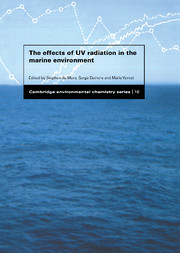Book contents
- Frontmatter
- Contents
- Contributors
- Preface
- 1 Enhanced UV radiation – a new problem for the marine environment
- 2 UV physics and optics
- 3 Spectral weighting functions for quantifying effects of UV radiation in marine ecosystems
- 4 Marine photochemistry and its impact on carbon cycling
- 5 Photochemical production of biological substrates
- 6 Mechanisms of UV damage to aquatic organisms
- 7 Strategies for the minimisation of UV-induced damage
- 8 UV radiation effects on heterotrophic bacterioplankton and viruses in marine ecosystems
- 9 Effects of UV radiation on the physiology and ecology of marine phytoplankton
- 10 Impact of solar UV radiation on zooplankton and fish
- 11 Implications of UV radiation for the food web structure and consequences on the carbon flow
- Index
9 - Effects of UV radiation on the physiology and ecology of marine phytoplankton
Published online by Cambridge University Press: 20 August 2009
- Frontmatter
- Contents
- Contributors
- Preface
- 1 Enhanced UV radiation – a new problem for the marine environment
- 2 UV physics and optics
- 3 Spectral weighting functions for quantifying effects of UV radiation in marine ecosystems
- 4 Marine photochemistry and its impact on carbon cycling
- 5 Photochemical production of biological substrates
- 6 Mechanisms of UV damage to aquatic organisms
- 7 Strategies for the minimisation of UV-induced damage
- 8 UV radiation effects on heterotrophic bacterioplankton and viruses in marine ecosystems
- 9 Effects of UV radiation on the physiology and ecology of marine phytoplankton
- 10 Impact of solar UV radiation on zooplankton and fish
- 11 Implications of UV radiation for the food web structure and consequences on the carbon flow
- Index
Summary
Introduction
Phytoplankton processes govern the synthesis of organic carbon in marine surface waters. The rate of change of phytoplankton concentration (P) in the euphotic zone is a balance between growth (d– 1) and losses from cell respiration, carbon excretion, sedimentation and grazing. In addition, advection and diffusion can locally increase or decrease phytoplankton. These processes can be summarised as:
dP/dt = P(growth – respiration – excretion – sedimentation – grazing)
Algal growth depends on carbon input by photosynthesis and is influenced by environmental conditions as well as ecological factors. In turn, physiological adaptation and cell metabolism respond to the environmental forcing to maximise survival. Light quality and quantity, nutrient availability and temperature all affect carbon uptake. Thus, phytoplankton are limited to surface waters as they are dependent on visible light (400–700 nm) for photosynthesis. The requirement for solar radiation makes them vulnerable to UV radiation (UVR) (280–400 nm) exposure (Raven, 1991; Gieskes & Buma, 1997), in particular UV-A (320–400 nm), although UV-B (280–320 nm) is more damaging per photon. UV-B, which accounts approximately for 0.01% of the photons absorbed by phytoplankton (Falkowski & Raven, 1997), is damaging to different molecular targets (see Chapters 6 and 7). Net damage at the cellular and population level is a balance between damage and repair (Vincent & Roy, 1993; Cullen & Neale, 1994) as documented for photosynthesis (Cullen et al., 1992; Lesser, Neale & Cullen, 1996; Hazzard, Lesser & Kinzie, 1997) and growth (Quesada, Mouget & Vincent, 1995). Exposure experiments to study UVR effects on phytoplankton have ranged from minutes to months, from molecular to community level, and for orders of magnitude difference in UVR. The relative rate of damage and repair in these disparate conditions is expressed both physiologically and ecologically.
- Type
- Chapter
- Information
- The Effects of UV Radiation in the Marine Environment , pp. 237 - 278Publisher: Cambridge University PressPrint publication year: 2000
- 21
- Cited by



